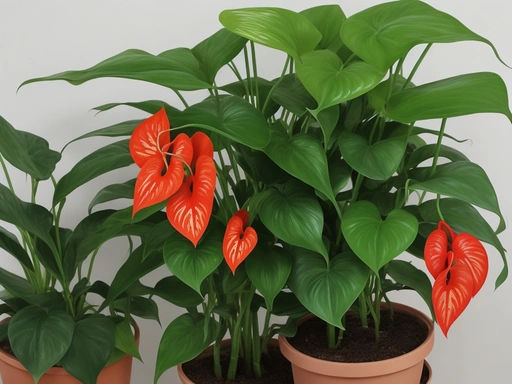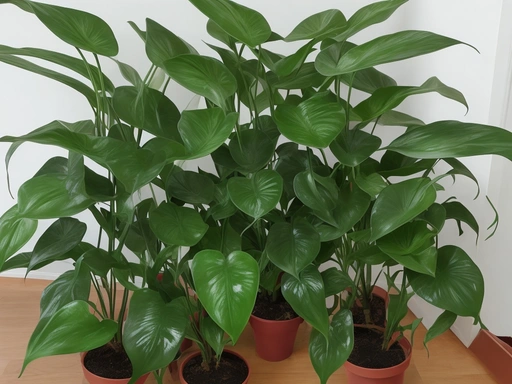Anthurium and Interior Design: The Perfect Combination for Elegance and Class!
Key Takeaways:
- Anthurium plants are a popular choice for interior design due to their bold and vibrant flowers.
- Anthuriums thrive in humid environments, making them well-suited for bathrooms and kitchens.
- The long-lasting blooms of Anthuriums make them a cost-effective option for adding color to your home.
- With proper care and maintenance, Anthuriums can add a touch of elegance and tropical charm to any indoor space.
Are you looking to spruce up your interior space and add a touch of natural beauty?
Look no further than anthurium plants.
Anthuriums are not just your average houseplants; they are the perfect choice for interior design.
With their striking aesthetic appeal, ability to enhance energy flow according to Feng Shui principles, and their air-purifying qualities, anthuriums are a must-have for any design-savvy homeowner.
In this article, I will guide you on how to choose the right anthurium for your space, provide styling tips, and share maintenance and care tips for keeping your anthurium thriving.
So, let’s dive in and discover how anthuriums can transform your home!
| Anthurium | Interior Design |
| Known for its vibrant flowers and glossy leaves | Enhances the aesthetic appeal of any room |
| Comes in a variety of colors, such as red, pink, and white | Offers versatility in color scheme choices |
| Requires moderate care and maintenance | Provides an opportunity for nurturing and decoration |
| Thrives in bright, filtered light | Brings life and freshness to dull corners |
| Can be placed in pots or hanging baskets | Suitable for different interior design styles and layouts |
| Symbolizes hospitality and friendship | Creates a warm and welcoming atmosphere |
Anthurium: The Perfect Plant for Interior Design
Anthurium is the ideal choice for interior design, thanks to its stunning aesthetic appeal and ability to enhance the energy and air quality in your home.
The Aesthetic Appeal of Anthurium
Anthurium plants have a stunning aesthetic appeal that can enhance any interior design.
With their vibrant and glossy leaves, along with unique and colorful flowers, Anthuriums bring a touch of elegance and beauty to any space.
Whether used as a focal point or as part of a lush green oasis, Anthuriums add a pop of color and a natural element to indoor environments.
They can complement a variety of design styles, from modern and sleek to vintage and boho-chic.
Anthuriums truly are a visually appealing addition to any interior.
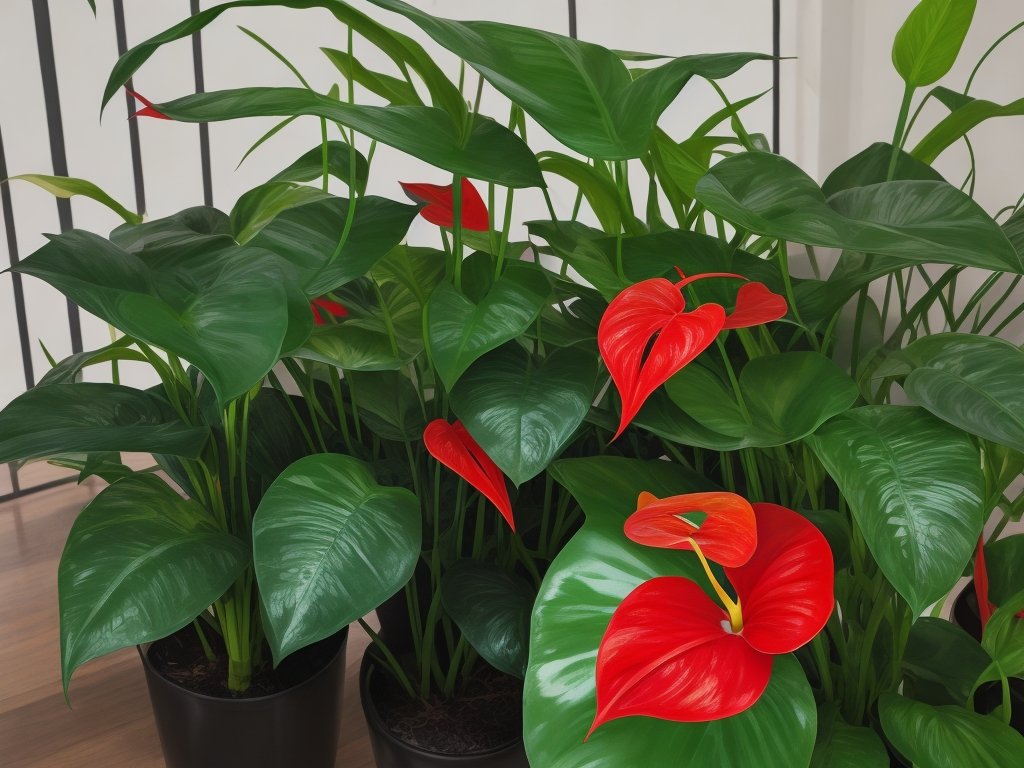
Anthurium and Feng Shui: Enhancing Energy in Your Home
Anthurium is believed to enhance energy flow, positivity, and abundance in Feng Shui.
Its heart-shaped leaves symbolize love, while its vibrant colors attract good luck.
Place Anthurium in the wealth or relationship area of your home to promote prosperity and harmonious relationships.
Keep it healthy to maintain its positive energy.
Anthurium and Biophilic Design: Bringing Nature Indoors
Anthurium is an excellent choice for incorporating biophilic design into your interior space. This design concept aims to bring nature indoors, promoting a harmonious and calming environment.
Anthurium’s vibrant foliage and beautiful flowers add a touch of natural beauty to any room.
The presence of plants like Anthurium can enhance well-being, reduce stress, and improve air quality. By strategically placing Anthurium in your interior design, you can create a space that feels connected to nature and promotes a sense of tranquility.
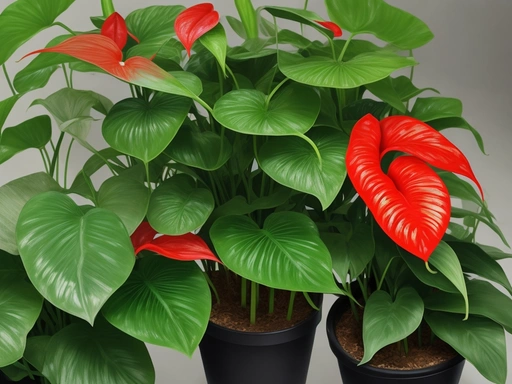
Anthurium as an Air Purifier: Improving Indoor Air Quality
Anthurium plants are excellent air purifiers that can improve indoor air quality. They have the ability to remove harmful toxins such as formaldehyde, xylene, and ammonia from the air, making it healthier to breathe.
Their large leaves and roots work together to absorb these pollutants and convert them into nutrients for the plant.
To maximize the air-purifying benefits, it is recommended to have multiple Anthurium plants in your space.
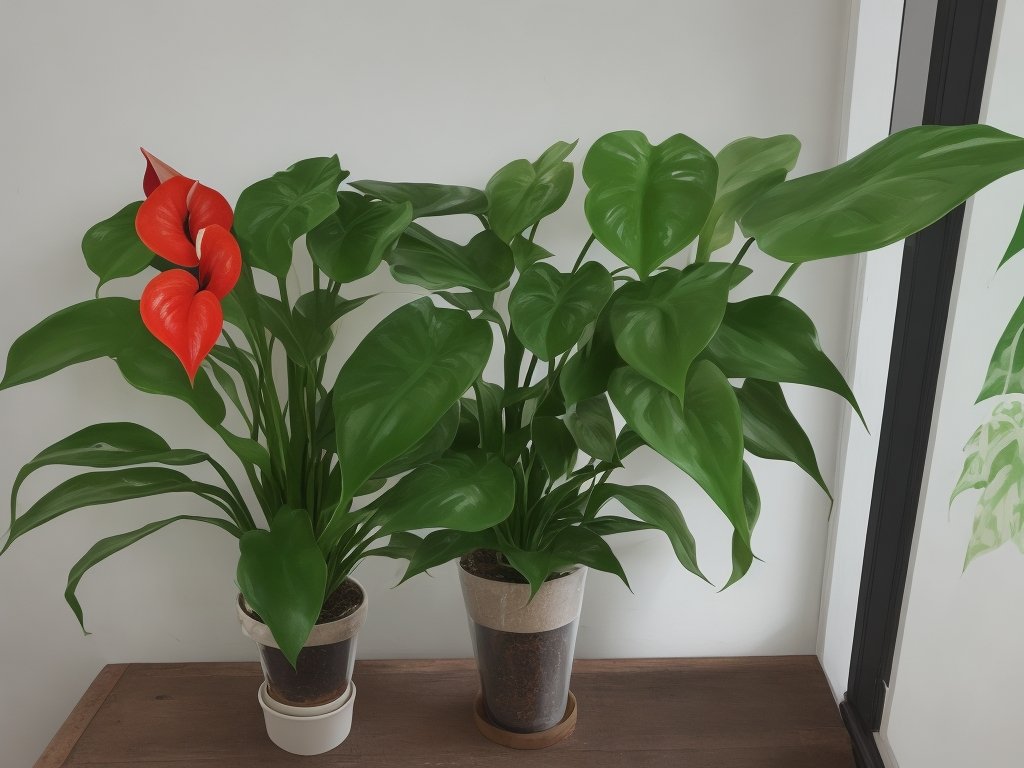
Choosing the Right Anthurium for Your Interior Space
Choosing the perfect Anthurium for your interior space requires considering factors such as size, color, and maintenance needs.
Anthurium Species: A Variety of Options
Anthuriums come in a wide variety of species, each with its own unique characteristics.
Some popular options include Anthurium andraeanum, known for its heart-shaped flowers, and Anthurium crystallinum, prized for its velvety leaves.
Other options include Anthurium clarinervium, Anthurium veitchii, and Anthurium warocqueanum.
Each species offers a different look and vibe to suit your interior design preferences.
Anthurium Care: Factors to Consider
When caring for an Anthurium, there are a few factors to consider.
Firstly, Anthuriums thrive in bright, indirect light, so it’s important to assess your lighting conditions.
Secondly, watering is crucial – allow the soil to dry slightly between waterings, but don’t let it completely dry out.
Lastly, Anthuriums prefer high humidity levels, so misting or placing it on a tray of water can help.
Consider these factors when caring for your Anthurium plant.
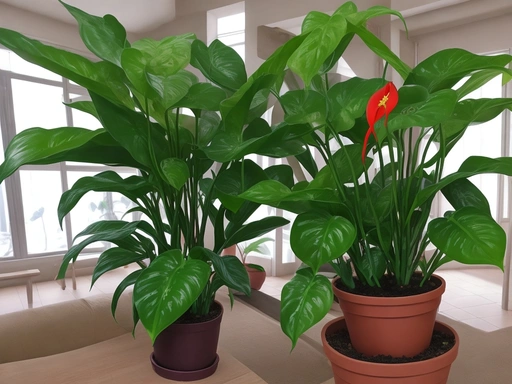
Assessing Lighting Conditions: The Key to Success
Assessing the lighting conditions is crucial for the success of your Anthurium.
Here are a few key points to consider:
- Light Intensity: Anthurium prefers bright indirect light. Avoid intense direct sunlight as it can scorch the leaves.
- Light Duration: Anthurium needs about 12-14 hours of light per day. Consider the natural light available in your space and supplement with artificial lighting if needed.
- Light Quality: Anthurium thrives under a full spectrum of light. LED grow lights or fluorescent lights are suitable options.
- Distance from Light Source: Place your Anthurium about 2-3 feet away from the light source to prevent leaf burn.
Remember, proper assessment of lighting conditions will ensure the health and growth of your Anthurium plant.
Picking the Perfect Pot: Enhancing the Overall Look
Choosing the right pot for your Anthurium is important for enhancing the overall look of your interior space. Consider these factors when picking the perfect pot:
- Size: Ensure the pot is large enough to accommodate the plant’s roots and allow for growth.
- Material: Opt for a pot made of ceramic, terracotta, or decorative containers to add a touch of style.
- Drainage: Look for pots with drainage holes to prevent waterlogging and root rot.
- Color and design: Select a pot that complements your interior design and enhances the aesthetic appeal of your Anthurium.
Styling Tips: Incorporating Anthurium into Your Interior Design
Anthurium can add a pop of color and texture to your interior design.
Let’s explore some styling tips to seamlessly incorporate it into your space.
Anthurium as a Focal Point: Creating a Statement Piece
Anthurium makes a bold statement as a focal point in interior design. Its vibrant colors and unique flowers draw attention and add a touch of elegance to any space.
Whether placed on a mantel, coffee table, or as a centerpiece, Anthurium instantly becomes the star of the room.
Its eye-catching beauty is sure to impress guests and make a lasting impression.
Mixing Anthurium with Other Houseplants: Creating a Lush Green Oasis
Mixing Anthurium with other houseplants is a great way to create a lush green oasis in your home. Anthurium’s glossy leaves and unique flowers add a stunning touch to any plant arrangement.
Consider pairing it with plants of varying heights, textures, and colors to create visual interest.
Some ideal companions for Anthurium include pothos, ferns, and snake plants. Aim for a balanced, cohesive look by arranging them in different-sized pots and grouping them together.
Remember to consider the lighting and water requirements of each plant to ensure they thrive together.
Anthurium in Modern Interiors: Sleek and Minimalistic Designs
Anthurium in modern interiors: Sleek and minimalistic designs can create a striking contrast and add a touch of nature to the clean lines and simplicity of modern decor.
The glossy leaves and vibrant blooms of Anthurium make for a stunning focal point in minimalist spaces.
The plant’s sleek and architectural shape complements the sleek and clean aesthetics of modern interior design.
Whether you choose a large Anthurium as a statement piece or small varieties to create subtle accents, Anthurium can bring a sense of freshness and life to any modern space.
Anthurium in Vintage Interiors: Adding a Touch of Nostalgia
Anthurium is an ideal choice for adding a touch of nostalgia to vintage interiors.
Its vibrant and unique flowers evoke a sense of a bygone era.
Place Anthurium in vintage-style pots or vases, and pair it with antique furniture or decor pieces to create a charming and nostalgic atmosphere.
The plant’s glossy leaves and long-lasting flowers will enhance the vintage aesthetic and bring a touch of natural beauty to your space.
Anthurium in Boho-Chic Interiors: Embracing Natural Elements
Anthurium is perfect for adding a touch of natural beauty to your boho-chic interior.
Its vibrant flowers and glossy leaves bring a tropical vibe.
Place it in woven baskets or macrame hangers, along with other plants.
The combination of lush greenery and natural elements will create a cozy and inviting space.
Maintenance and Care Tips for Anthurium in Interior Design
To keep your Anthurium thriving in your interior design, you’ll need to pay attention to its watering, lighting, fertilizing, repotting, and solving common problems. Let’s dive into the essential care tips!
Watering Anthurium: Finding the Right Balance
To find the right balance when watering your Anthurium, it’s important to consider their natural habitat.
These plants are native to tropical rainforests, where they receive consistent rainfall but also have well-draining soil.
Here are a few tips to keep in mind:
- Check the soil moisture: Before watering, make sure the top inch of soil is dry to the touch. Anthuriums don’t like constantly wet feet, so it’s best to let the soil dry out slightly between waterings.
- Water thoroughly but infrequently: When you do water, make sure to thoroughly saturate the soil until water comes out of the drainage holes. This will help to ensure that the roots receive enough water.
- Avoid overwatering: Anthuriums are sensitive to overwatering, so it’s important to avoid keeping their roots constantly wet. Allow the soil to dry out slightly between waterings to prevent root rot.
- Consider humidity levels: These plants thrive in higher humidity levels, so you can boost humidity by placing a tray of water near the plant or misting it regularly. Just be careful not to mist the flowers directly, as it can cause spotting.
- Observe and adjust: Every home and environment is different, so it’s important to observe your Anthurium and adjust your watering routine accordingly. If the leaves are turning yellow or wilting, it may be a sign of underwatering. On the other hand, if the leaves are drooping or the soil feels constantly damp, you may be overwatering.
By finding the right balance and paying attention to your Anthurium’s watering needs, you can help ensure that it thrives in your interior design.
Providing Proper Lighting for Anthurium
Providing proper lighting is crucial for Anthuriums. They thrive in bright, indirect light, so placing them near a window with filtered light is ideal.
Avoid direct sunlight, as it can scorch the leaves.
If you have low-light conditions, consider using artificial grow lights to supplement the natural light. Providing the right lighting conditions will ensure healthy growth and vibrant blooms for your Anthurium plant.
Fertilizing Anthurium: Nourishing Your Plant
To nourish your Anthurium plant, fertilizing is essential. Use a balanced houseplant fertilizer, diluted to half strength, during the growing season (spring and summer).
Apply it every 4-6 weeks.
Avoid over-fertilization, as it can damage the plant. Remember to follow the instructions on the fertilizer packaging.
Repotting Anthurium: Ensuring Healthy Growth
Repotting Anthurium ensures healthy growth by providing it with fresh, nutrient-rich soil and enough space for its roots to grow. Here are some key steps to follow:
- Choose a pot that is slightly larger than the current one, with good drainage holes.
- Gently remove the plant from its old pot, being careful not to damage the roots.
- Shake off excess soil and trim any damaged or excessively long roots.
- Place the plant in the new pot and fill it with fresh potting mix, making sure to evenly distribute the soil around the roots.
- Water the plant thoroughly to help it settle into its new home.
- Place the repotted Anthurium in a location with appropriate light and temperature conditions. Remember to avoid direct sunlight, which can scorch the leaves.
Dealing with Common Anthurium Problems: Tips and Tricks
Dealing with Common Anthurium Problems: Tips and Tricks Anthurium plants, like any houseplant, can face certain problems.
Here are some tips and tricks to help you deal with common issues:
- Yellowing leaves: If your Anthurium’s leaves are turning yellow, it could be due to overwatering or insufficient sunlight. Adjust your watering schedule and ensure your plant gets enough light.
- Root rot: Overwatering can lead to root rot, causing the roots to become mushy and dark. To prevent this, allow the soil to dry out between waterings and ensure proper drainage.
- Pests: Common pests that can affect Anthuriums include aphids, mealybugs, and spider mites. Use an organic insecticide or wipe the leaves with a solution of soap and water to get rid of them.
- Brown tips: Brown tips on the leaves can indicate low humidity or excessive fertilizer. Increase humidity by misting the leaves or using a humidifier. Avoid overfertilizing and follow the recommended dosage.
- Wilting: Wilting can occur if your Anthurium is exposed to too much direct sunlight or if it’s not getting enough water. Find a suitable location with bright, indirect light and ensure consistent watering.
Remember, each Anthurium plant is unique, so it’s important to observe and adjust your care routine accordingly.
With these tips, you’ll be well equipped to tackle common problems and keep your Anthurium thriving.
Frequently Asked Questions about Anthurium and Interior Design
Can Anthurium thrive in low-light conditions?
Anthurium can tolerate low-light conditions, but it may not thrive.
It prefers bright, indirect light to produce vibrant flowers and healthy foliage.
If you have limited light, choose Anthurium varieties that are more tolerant of shade, such as Anthurium clarinervium or Anthurium scandens.
Remember to provide them with regular care and monitor their growth.
How often should I water my Anthurium?
Water your Anthurium when the top inch of soil feels dry to the touch. Stick your finger into the soil to check the moisture level.
It’s better to underwater than overwater, as Anthuriums prefer slightly drier conditions.
Aim for once every 7-10 days, but adjust based on your specific environment.
Can I grow Anthurium in a bathroom with high humidity?
Yes, you can definitely grow Anthurium in a bathroom with high humidity. Anthuriums enjoy humid environments, making them the perfect choice for bathrooms.
Just make sure to place them in a spot with bright, indirect light and water them regularly to keep the soil moist but not overly saturated.
Are all Anthurium species suitable for interior design?
No, not all Anthurium species are suitable for interior design.
Some species have specific care requirements and may not thrive in indoor environments.
It’s important to choose species that are well-suited for indoor conditions, such as Anthurium andraeanum and Anthurium clarinervium.
These species are known for their durability and adaptability to indoor spaces.
How do I propagate Anthurium plants?
To propagate Anthurium plants, you can use two methods: division and stem cuttings. For division, carefully remove the plant from its pot and separate the roots into smaller sections with at least two leaves per section.
Plant each section in a separate pot.
For stem cuttings, take a healthy stem with a few leaves, make a clean cut below a leaf node, and place it in a jar of water or a well-draining potting mix. Keep the soil moist and wait for new roots to develop.
Final Verdict
Anthurium is indeed the perfect plant for interior design. Its aesthetic appeal, ability to enhance energy in your home through Feng Shui, and its contribution to the biophilic design trend make it a versatile and sought-after plant.
With a variety of Anthurium species to choose from and careful consideration of lighting conditions and pot selection, you can easily incorporate Anthurium into any interior space.
By following maintenance and care tips, you can ensure the healthy growth of your Anthurium plant and enjoy its beauty for years to come. Whether used as a focal point or mixed with other houseplants, Anthurium is sure to elevate the design of any interior.



